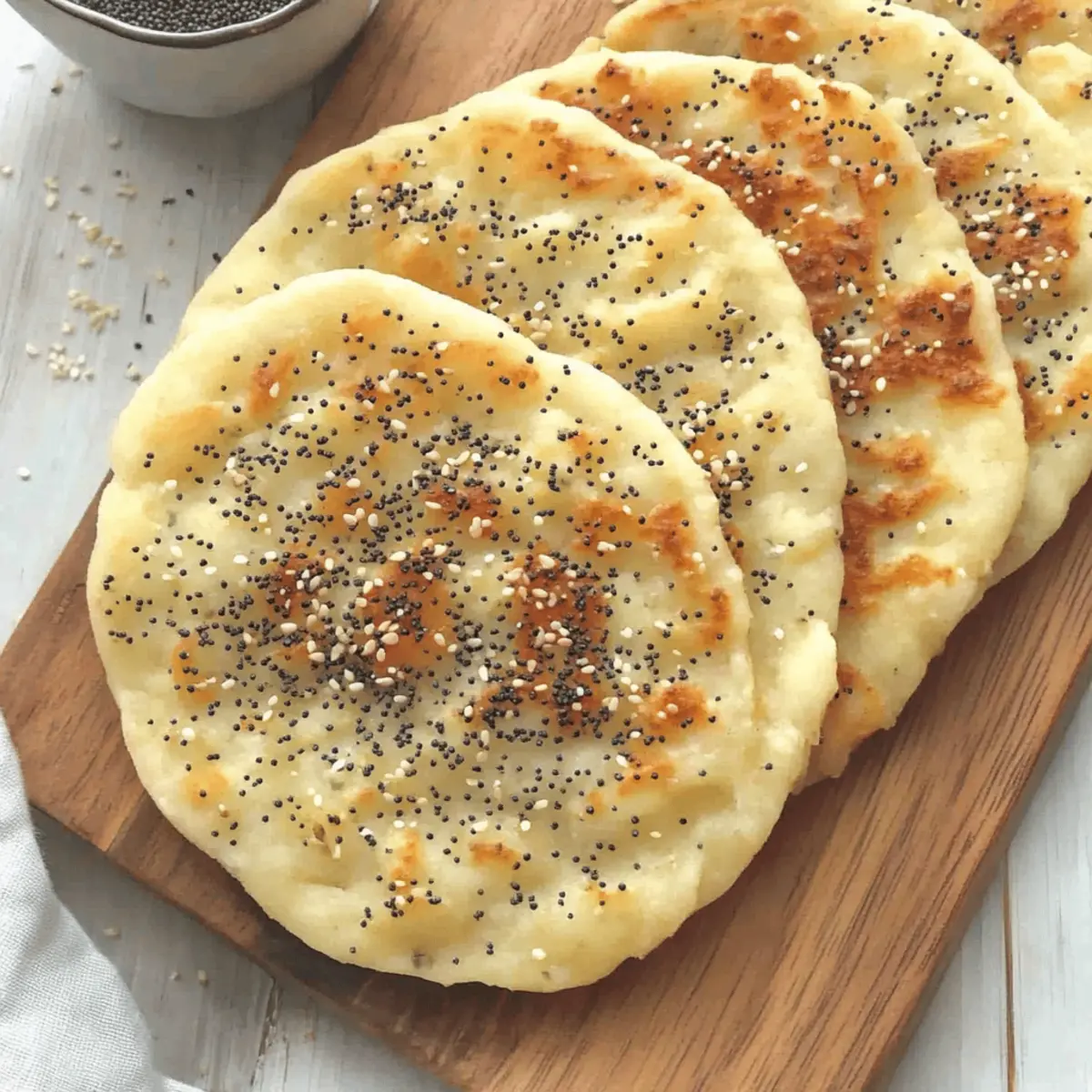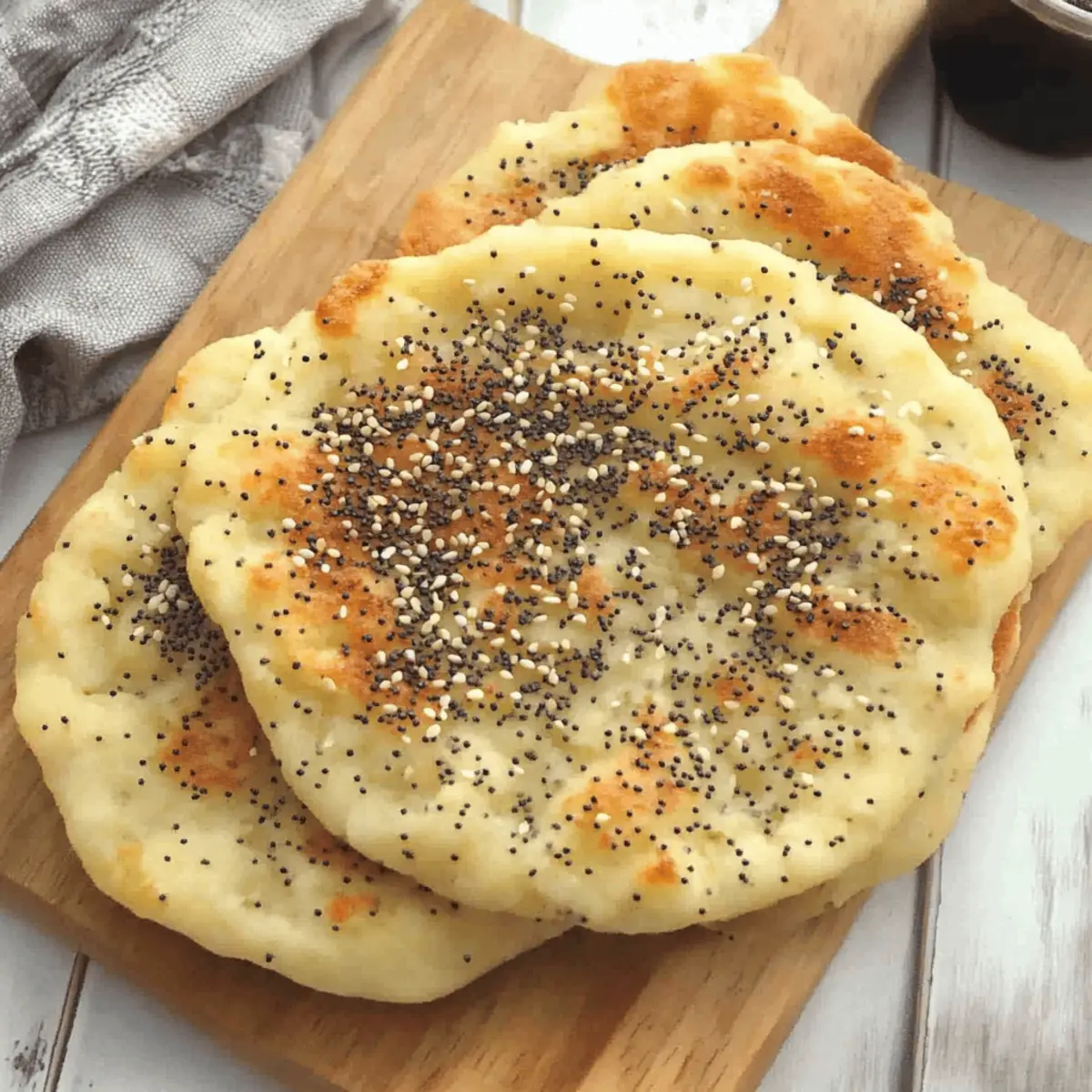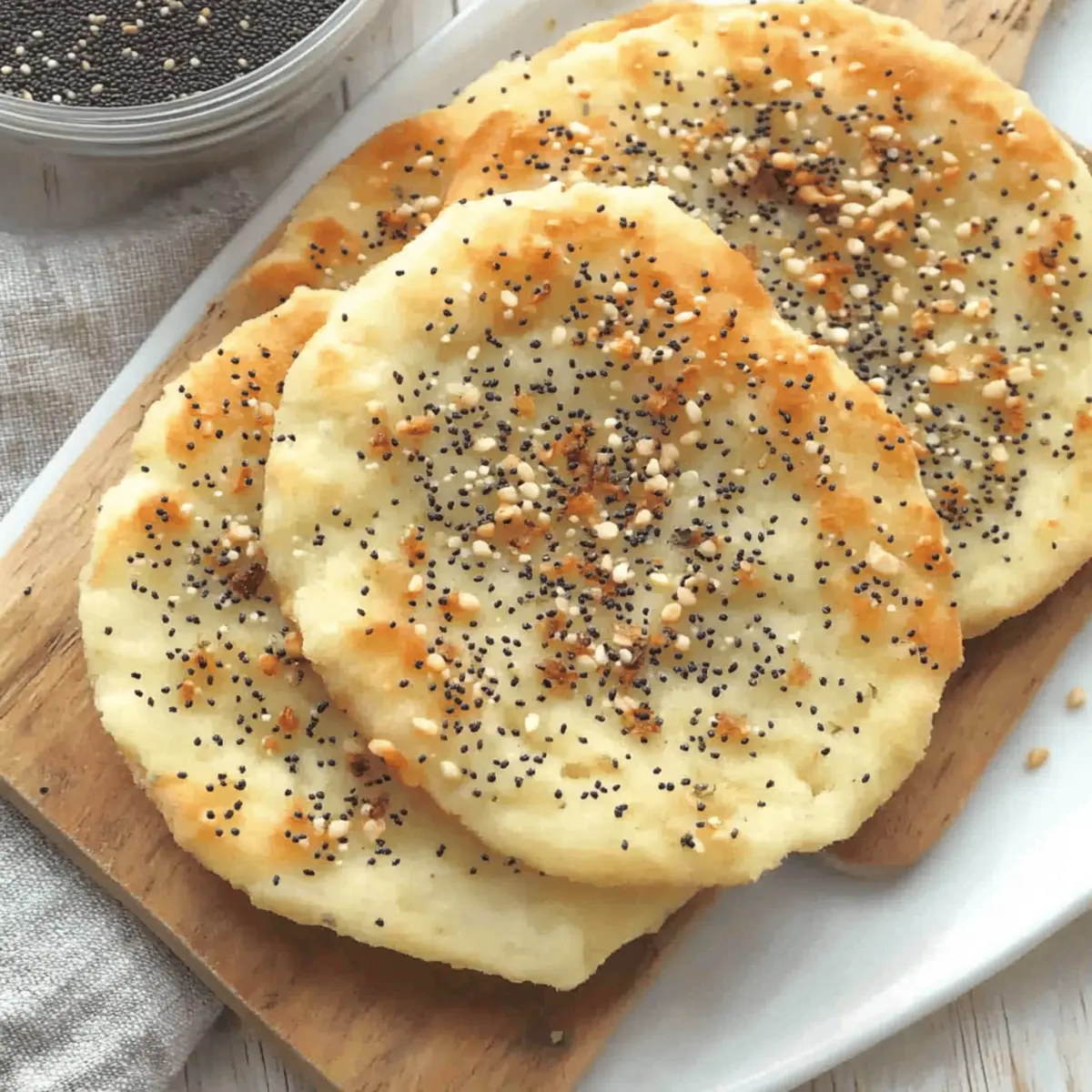As the warm aroma of baking bread fills the kitchen, I can’t help but feel a wave of comfort wash over me. This Gluten Free Everything Mashed Potato Flatbread brings a delightful twist to your dinner table, transforming leftover mashed potatoes into an enticing side dish that’s light yet satisfying. Not only is this easy bread recipe perfect for scooping up soups or slathering with your favorite spreads, but it also caters to gluten-free lifestyles without sacrificing flavor. Whether you’re looking to impress your guests or simply enjoy a homemade treat, these flatbreads will elevate any meal. Are you ready to embrace the joy of cooking and create a dish that’ll leave your family asking for more? Let’s dive in!

Why Choose Mashed Potato Flatbread?
Flavor Explosion: The blend of potatoes with everything bagel spices delivers a unique taste that elevates everyday meals.
Easy Preparation: You’ll love how quick and simple it is to whip together this flatbread, making it perfect for any weeknight dinner.
Gluten-Free Delight: Ideal for those avoiding gluten, this recipe doesn’t skimp on taste or texture.
Versatile Use: Enjoy these flatbreads as a side, sandwich base, or even with your favorite spreads. Try pairing them with a warm soup or alongside zesty dishes like Savory Onion Potato for an even more delightful experience!
Crowd-Pleaser: Homemade comfort food always impresses, ensuring they’ll be a hit at the dinner table. Get ready for compliments!
Mashed Potato Flatbread Ingredients
For the Dough
• Prepared Mashed Potatoes – Use 2 cups of freshly made or leftover mashed potatoes for a moist base.
• Melted Butter – Adds richness and flavor; substitute with dairy-free butter for a dairy-free option.
• Egg – Binds the dough and helps give structure; can be replaced with a flax or chia seed egg for a vegan version.
• Rice Flour – Supplies the gluten-free structure; sorghum or almond flour can also work as substitutes.
• Corn Starch (or Tapioca/Potato Starch) – Essential for a light and fluffy texture in your mashed potato flatbread.
• Baking Powder – Acts as a leavening agent to give the flatbreads their desired rise.
• Salt – Enhances overall flavor and balances the dough.
For the Everything Topping
• Poppy Seeds – Add a delightful crunch and nutty flavor to the finish.
• Sesame Seeds – Contributes a rich nutty taste and extra texture.
• Dried Garlic – Brings a depth of flavor; can be swapped with garlic powder if desired.
• Dried Onion – Adds a savory, aromatic element for a full-flavored topping.
• Dried Basil – Offers a lovely aromatic note that complements the everything spices.
• Salt – Don’t forget to season the everything topping to elevate its flavor.
Embrace this mashed potato flatbread recipe for an easy and delicious side that’s sure to be a family favorite!
Step‑by‑Step Instructions for Mashed Potato Flatbread
Step 1: Prepare Potatoes
Begin by boiling 2 cups of peeled potatoes in salted water for about 15–20 minutes, or until tender. Once cooked, drain and mash the potatoes until smooth. If using leftover mashed potatoes, ensure they are at room temperature before proceeding. Allow the mashed potatoes to cool completely before combining with the other ingredients.
Step 2: Mix Ingredients
In a large mixing bowl, combine the cooled mashed potatoes, 4 tablespoons of melted butter, and 1 egg. Utilize a wooden spoon or spatula to mix these ingredients until the mixture becomes smooth and well-combined. This step will ensure your mashed potato flatbread has a rich and cohesive flavor profile.
Step 3: Add Dry Ingredients
Next, sift in 1 cup of rice flour, ½ cup of corn starch, 1 teaspoon of baking powder, and ½ teaspoon of salt into the potato mixture. Stir gently until a smooth dough forms. The dough should be slightly sticky but manageable; if it feels too wet, you can gradually add more rice flour until you reach the desired consistency.
Step 4: Chill Dough
Wrap the dough tightly in plastic wrap and place it in the refrigerator for 30 minutes. This resting period allows the dough to firm up, making it easier to shape into flatbreads later. Take this time to preheat your oven for optimal baking conditions.
Step 5: Preheat Oven
Set your oven to 450°F (230°C) and let it preheat while the dough chills. A hot oven is essential for achieving that beautifully golden-brown exterior on your mashed potato flatbread. Make sure the oven is fully heated before placing the flatbreads inside to bake.
Step 6: Shape Flatbreads
Once the dough has chilled, dust a clean surface with rice flour. Divide the dough into 8 equal pieces, rolling each into a ball. Then, flatten each ball gently with your hands until they are approximately ½ inch thick. This shaping will help create the ideal form for your mashed potato flatbread.
Step 7: Prepare Topping
In a small mixing bowl, combine 1 tablespoon each of poppy seeds and sesame seeds, along with 1 teaspoon each of dried garlic, dried onion, and dried basil, and a pinch of salt. Mix these ingredients well to create your everything topping, which will add irresistible flavor and texture to the flatbreads.
Step 8: Bake
Line a baking sheet with parchment paper and arrange the shaped flatbreads evenly on it. Brush each flatbread with the remaining melted butter, then generously sprinkle the everything topping over the surface. Bake the flatbreads in the preheated oven for about 15 minutes, or until they are golden brown and slightly crisp on the edges, keeping a close eye to avoid overbaking.

Make Ahead Options
These Gluten Free Everything Mashed Potato Flatbreads are perfect for meal prep enthusiasts looking to save time during busy weeknights! You can prepare the dough up to 24 hours in advance; simply follow the recipe through Step 4, then wrap the dough tightly in plastic wrap and refrigerate it. This chilling step not only makes the dough easier to work with but also helps maintain its quality. When you’re ready to bake, preheat your oven and shape the flatbreads as described in Steps 5 through 8. You’ll have delicious, homemade flatbreads that are just as fluffy and flavorful, making dinner a breeze!
Storage Tips for Mashed Potato Flatbread
Room Temperature: Keep any leftover flatbreads at room temperature for up to 2 days, wrapped in a clean kitchen towel to maintain moisture.
Fridge: Store flatbreads in an airtight container in the refrigerator for up to 3 days. This helps retain their freshness and flavor.
Freezer: Freeze the flatbreads for up to 2 months. Place parchment paper between each flatbread to prevent sticking, then seal in an airtight bag.
Reheating: For the best results, reheat frozen flatbreads in the oven or air fryer at 350°F (175°C) until warm and crispy, bringing back that delicious flavor of homemade mashed potato flatbread!
What to Serve with Gluten Free Everything Mashed Potato Flatbread?
Transform your meal into a complete experience that delights every palate with these delightful pairing suggestions.
-
Creamy Tomato Soup: This classic combo offers comforting flavors that complement the soft texture of the flatbread perfectly. Dip your flatbread to soak up the rich soup!
-
Herbed Garden Salad: A fresh salad with crisp greens, tomatoes, and a zesty vinaigrette balances the fluffy bread, adding a refreshing crunch. Each bite can be made better with a touch of flatbread.
-
Savory Roasted Vegetables: Oven-roasted veggies, seasoned to perfection, provide earthy flavors that enhance the taste of your flatbread. It’s a hearty side that makes for an inviting plate.
-
Pulled Pork or Chicken: Serve your flatbread as a delicious sandwich base for tender pulled meat, topped with tangy coleslaw. The soft bun-like texture plays well with the juicy fillings.
-
Cheesy Spinach Dip: Warm, gooey spinach dip is the perfect spread for your flatbread, offering a delightful savory explosion with every bite. The flatbread serves as an excellent vehicle for that cheesy goodness.
-
Chilled White Wine: A crisp, refreshing glass of white wine, like Sauvignon Blanc, brings out the flavors of everything topping, making each bite of the flatbread shine as you sip.
-
Chocolate Chip Cookies: Satisfy your sweet tooth after a meal with soft, warm cookies. The dessert contrasts beautifully with the savory flatbread, rounding out your dining experience perfectly!
Tips for the Best Mashed Potato Flatbread
-
Cool Potatoes First: Ensure the mashed potatoes are completely cool before mixing; warm potatoes can affect the texture and make the dough sticky.
-
Watch Baking Time: Keep a close eye on the flatbreads while baking; they should turn golden brown, but overbaking can lead to a dry result.
-
Adjust Flour Gradually: If the dough feels too sticky, add rice flour a little at a time until it reaches the right consistency for shaping your mashed potato flatbread.
-
Perfect Topping: Don’t skimp on the everything topping; it adds vital flavor. Make sure to mix it well to evenly distribute the spices.
-
Store Properly: For leftovers, store in an airtight container and refrigerate, or freeze for longer storage. Reheat in the oven for the best taste!
Mashed Potato Flatbread Variations
Feel the freedom to personalize this recipe and enhance its deliciousness to your liking!
-
Dairy-Free: Swap melted butter with coconut oil or a plant-based butter for a totally dairy-free version. Enjoy the fantastic richness without any dairy!
-
Vegan: Replace the egg with a flax or chia seed egg to make this flatbread vegan-friendly. A simple mix of water and ground seeds brings a lovely binding and nutrient-rich element to your dough.
-
Herb-Infused: Mix in your favorite herbs like rosemary or thyme into the dough for an aromatic twist. Imagine the delicious scents filling your kitchen as these flavor-infused flatbreads bake!
-
Cheesy Goodness: Stir in nutritional yeast or grated vegan cheese for an extra savory flavor. The cheesy touch will add depth and richness that everyone will love.
-
Spicy Kick: Add a pinch of crushed red pepper flakes to the dough for a hint of heat. Whether it’s alongside your sandwich or dipped into sizzling soups, that little spice can take your flatbread to the next level!
-
Nutty Texture: Substitute half of the rice flour with almond flour for a delightful nutty flavor and unique texture. This change will give your flatbreads an intriguing crunch for a fun twist!
-
Sweet Treat: Use sweet potato instead of regular potatoes for a naturally sweet flavor. Top with cinnamon sugar for a delightful dessert flatbread that pairs wonderfully with coffee or tea.
-
Serving Suggestions: Try serving these delightful flatbreads with a warm bowl of your favorite soup or alongside Savory Chicken and Cheesy Potato Drumsticks for a comforting meal!
Let your creativity soar with these variations and create something truly special!

Mashed Potato Flatbread Recipe FAQs
How do I choose the right potatoes for this recipe?
Absolutely! For the best mashed potato flatbread, I recommend using starchy potatoes like Russets or Yukon Golds. These types yield a fluffier texture when mashed. If you choose waxy potatoes, your flatbread may turn out denser, which we want to avoid for that delightful lightness.
How should I store leftovers?
Very simple! Leftover flatbreads can be kept in an airtight container in the refrigerator for up to 3 days. I often wrap them in parchment paper before placing them in the container to preserve their moisture. If you have a larger batch, consider freezing them for up to 2 months, separating each flatbread with parchment paper to prevent sticking.
Can I freeze mashed potato flatbreads, and how?
Yes, indeed! To freeze your flatbreads, first let them cool completely after baking. Then, stack them with a piece of parchment paper between each one to prevent sticking and place them in a freezer-safe bag or container. They’re best enjoyed within 2 months, but they’re still delicious if longer stored. When you’re ready to eat, reheat them in an oven at 350°F (175°C) for about 10-15 minutes to revive that fresh-baked texture.
What if the dough is too sticky?
No worries! If you find your dough to be too sticky while preparing, simply sprinkle a little extra rice flour into the mixture, a tablespoon at a time, kneading gently until you reach a smoother consistency. Remember, it’s better to add it gradually to avoid making the dough too dry, which can happen if you add too much flour at once.
Are there any dietary considerations I should keep in mind?
Certainly! This recipe is naturally gluten-free, which makes it a great choice for those with celiac disease or gluten intolerance. If you’re making it vegan, simply replace the egg with a flax or chia seed egg. Additionally, for allergies, use dairy-free butter if lactose is a concern. Just check your specific ingredient labels to ensure they meet dietary needs.
How can I transport these flatbreads?
Transporting your flatbreads is quite easy! Once they have cooled, wrap them in foil or wax paper and place them in a container to keep them fresh. If you’re bringing them to a potluck or picnic, consider adding a small container of your favorite dip or spread to complement the flatbreads, making them an even more inviting offering!
This Mashed Potato Flatbread recipe is not only versatile and delicious but also simple to customize to fit your preferences. Happy cooking!

Fluffy Mashed Potato Flatbread That's Gluten-Free Delight
Ingredients
Equipment
Method
- Begin by boiling 2 cups of peeled potatoes in salted water for about 15–20 minutes, or until tender. Once cooked, drain and mash the potatoes until smooth. If using leftover mashed potatoes, ensure they are at room temperature before proceeding. Allow the mashed potatoes to cool completely before combining with the other ingredients.
- In a large mixing bowl, combine the cooled mashed potatoes, 4 tablespoons of melted butter, and 1 egg. Utilize a wooden spoon or spatula to mix these ingredients until the mixture becomes smooth and well-combined.
- Next, sift in 1 cup of rice flour, ½ cup of corn starch, 1 teaspoon of baking powder, and ½ teaspoon of salt into the potato mixture. Stir gently until a smooth dough forms.
- Wrap the dough tightly in plastic wrap and place it in the refrigerator for 30 minutes.
- Set your oven to 450°F (230°C) and let it preheat while the dough chills.
- Once the dough has chilled, dust a clean surface with rice flour. Divide the dough into 8 equal pieces, rolling each into a ball. Flatten each ball gently until they are approximately ½ inch thick.
- In a small mixing bowl, combine 1 tablespoon each of poppy seeds and sesame seeds, along with 1 teaspoon each of dried garlic, dried onion, and dried basil, and a pinch of salt. Mix these ingredients well.
- Line a baking sheet with parchment paper and arrange the shaped flatbreads evenly on it. Brush each flatbread with the remaining melted butter, then generously sprinkle the everything topping over the surface. Bake the flatbreads for about 15 minutes, or until they are golden brown and slightly crisp on the edges.

